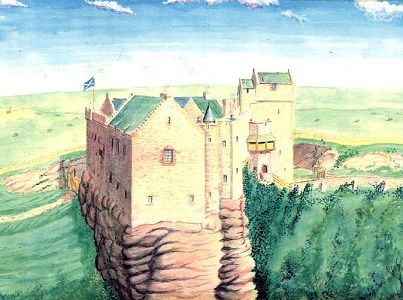|
Artist: Andrew Spratt Custodian of Dirleton Castle. These images are the copyright of Mr. Spratt who has generously given permission to display them here. For more about Andrew Spratt click here. For a complete index of Mr. Spratt's castles on this site click here. Other galleries of Mr. Spratt's work may be viewed at Clan Douglas and Clan Sinclair. Click on the castle to the left to view a larger image and scroll down to read more about the castle. |
|
|
|||
|
Several miles east of the village of Innerwick, near Dunbar in East Lothian, perched on top of a sandstone outcrop, overhanging the Thorton ravine stands the vaulted basements of Innerwick castle. The present ruin dates from the 1400's and 1500's and was a keep with an outer courtyard wall, with a gradual infill of additional buildings as time went on. The original castle site though dates back to the mid 1300's when it was built for the Stewarts. In 1398,the castle passed to the Hamiltons, ancestors of the Earls of Haddington. In 1403 Innerwick was besieged by the English knight 'Hotspur' Percy and Archibald 4th Earl of Douglas, a Scot held by the Percies since the defeat of the Scots army at the battle of Homildon Hill, near Wooler, in 1402. However the siege of Innerwick and it's near neighbour Cocklaws tower, a Gladstone house, proved to be a mock affair and a smoke screen, for when the Duke of Albany arrived with a large Scots army to save Innerwick and Cocklaws, Percy and Douglas had headed south-west to contact Douglas vassals and march on Wales. Percy, Douglas and his men were now in league with Owen of Glendower in open revolt against King Henry IV of England (1399-1413). But at the battle of Shrewsbury 'Hotspur' was killed, Douglas retaken captive and the rebels defeated.
The castle of Innerwick can't have been completely destroyed as it was being used by Scots horsemen, in 1650,as a base to attack Cromwell's supply lines, in conjunction with the raids made by the 'desperado gallants' of Tantallon castle, near North Berwick and the 'moss troopers' of Dirleton castle. It appears though that Innerwick was 'quitted' by the Scots as only Tantallon and Dirleton are recorded as being bombarded and stormed in letters of the time. The occupation of the Lothians by Cromwell, and his systematic destruction of castles therein, proved that the days of the mighty stone castle was over. Modern cannon could fell any monument great or small. For this reason from the 1650's onwards castles were no longer repaired or rebuilt as the expense made it a futile exercise. Innerwick like so many other castles fell the fate of being viewed as the local quarry.
|
